You’ve probably noticed that smart home technology keeps getting more complicated, with hubs, bridges, and countless apps cluttering your setup. Hub-free garage door controls cut through this complexity by connecting directly to your Wi-Fi network, eliminating the middleman entirely. While traditional smart garage systems demand additional hardware investments and ongoing maintenance headaches, there’s a compelling case for why ditching the hub might transform your entire approach to home automation.
What Are Hub-Free Garage Door Controls?
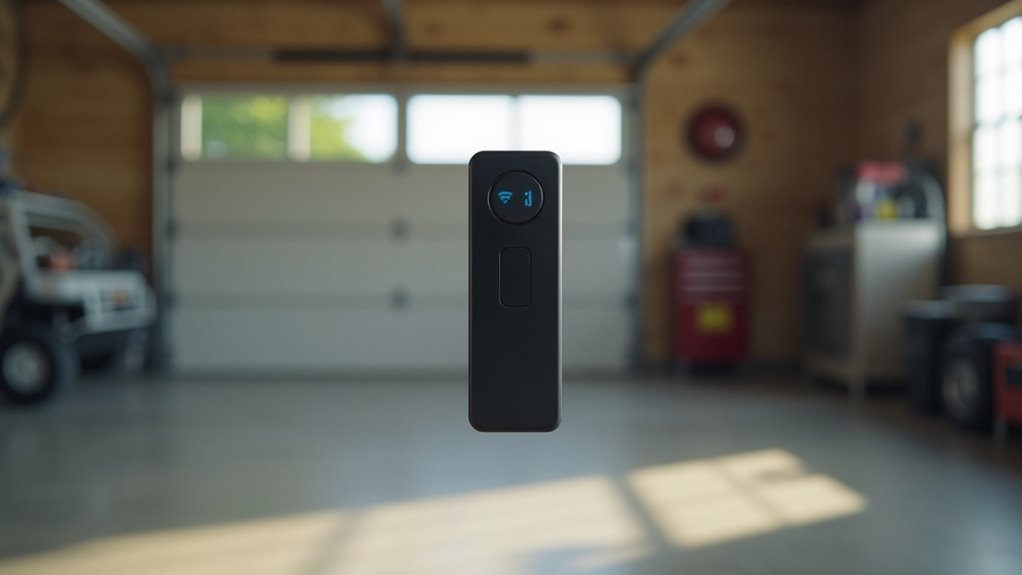
Hub-free garage door controls eliminate the middleman between your smartphone and garage door opener by connecting directly to your home’s Wi-Fi or Bluetooth network.
Unlike traditional smart home devices that require separate hub hardware, these systems streamline your setup by working with your existing garage door opener immediately after installation.
You’ll enjoy seamless integration with popular voice assistants like Amazon Alexa and Google Assistant, enabling hands-free operation through simple voice commands.
The technology delivers real-time notifications about your garage door’s status directly to your smartphone, whether you’re home or away.
Compatible with most garage door openers manufactured after 1993, hub-free garage door controls offer a versatile, user-friendly solution that simplifies smart home automation without additional complexity.
Key Advantages of Hub-Free Systems
Beyond understanding how these systems operate, you’ll discover that choosing hub-free garage door controls offers significant practical benefits for your smart home setup. These systems connect directly to your Wi-Fi signal, eliminating additional hardware costs and setup complexity. You’ll receive real-time notifications instantly on your smartphone, enabling quick response to security concerns. The streamlined design provides reliable remote access without dependency on multiple devices that could fail.
| Feature | Hub-Free Advantage | Traditional Hub System |
|---|---|---|
| Installation | Direct Wi-Fi connection | Requires separate hub device |
| Response Time | Minimal latency | Potential delays through hub |
| Maintenance | Single device upkeep | Multiple components to manage |
Your smart homes benefit from simplified integration, faster response times, and reduced points of failure, making hub-free garage door controls an efficient choice.
Direct Wi-Fi Connection Benefits
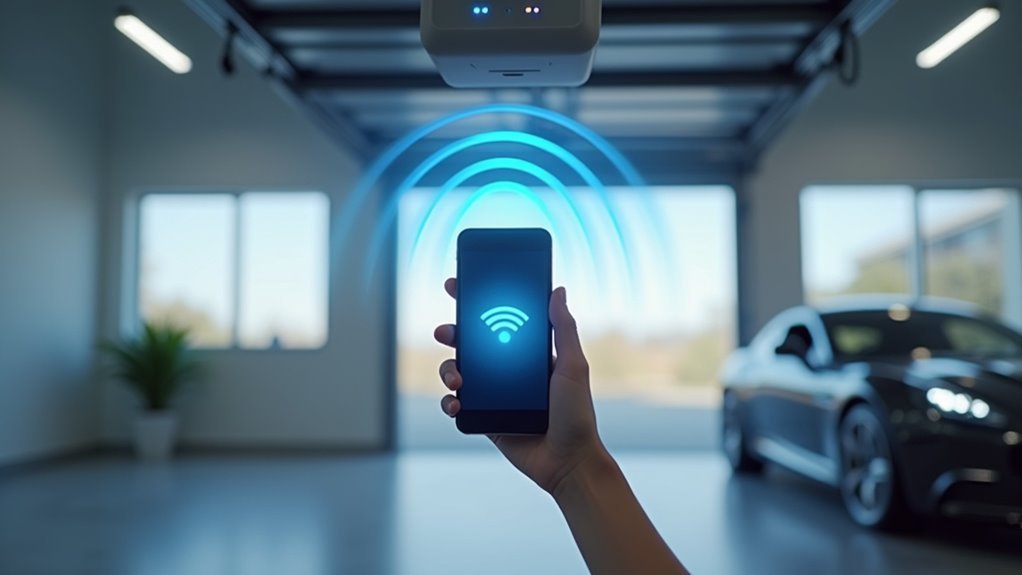
You’ll eliminate unnecessary network layers when your garage door controller connects directly to your Wi-Fi router.
This streamlined setup reduces the number of devices that can fail or cause communication delays in your smart home network.
Your garage door responds faster and more consistently without data passing through multiple connection points.
Reduced Network Complexity
When you eliminate the need for a separate hub, your garage door control system becomes considerably simpler to manage and maintain.
Hub-free systems reduce network complexity by connecting directly to your existing Wi-Fi network, cutting out the middleman entirely. This streamlined approach means you’ll eliminate additional device management while experiencing fewer potential points of failure.
You’ll notice improved performance with reliable response time since commands travel directly from your smartphone to the garage door opener without routing through extra hardware.
The simplified network architecture also enables seamless integration with your current smart home ecosystem. Without hub hardware requiring updates, configurations, or troubleshooting, you’re left with a straightforward system that just works, making your daily garage door operations more dependable and hassle-free.
Enhanced Connection Reliability
Direct Wi-Fi connections take this simplified approach one step further by establishing a rock-solid link between your garage door opener and your home network.
When you choose garage door openers manufactured with hub-free technology, you’re eliminating the latency and connectivity issues that plague hub-based systems. This enhanced reliability means your garage door responds faster to commands and delivers consistent performance.
Direct Wi-Fi connections minimize potential failure points by removing intermediary hardware from the equation. You’ll receive real-time alerts without delays since there’s no hub causing bottlenecks.
The installation process becomes straightforward—simply connect your opener directly to your existing Wi-Fi network. This streamlined approach supports both IPv4 and IPv6 protocols, ensuring your system remains compatible as network technologies advance while maintaining superior connection stability.
Simplified Installation Process
Unlike traditional smart garage door systems that require multiple components and complex wiring, hub-free controls offer a pleasantly straightforward installation process that you can complete in about 20 minutes.
You’ll only need a garage door opener with standard safety sensors, making setup accessible even if you’re not tech-savvy.
You can mount these systems flexibly on your ceiling or side wall, provided you’re within 50 feet of your Wi-Fi router.
The built-in Wi-Fi connectivity eliminates additional hubs, reducing clutter in your smart home setup.
User-friendly mobile apps guide you through each installation step, providing real-time notifications and ensuring you won’t get lost during the process.
This streamlined approach makes upgrading to smart garage control remarkably simple.
Enhanced System Reliability
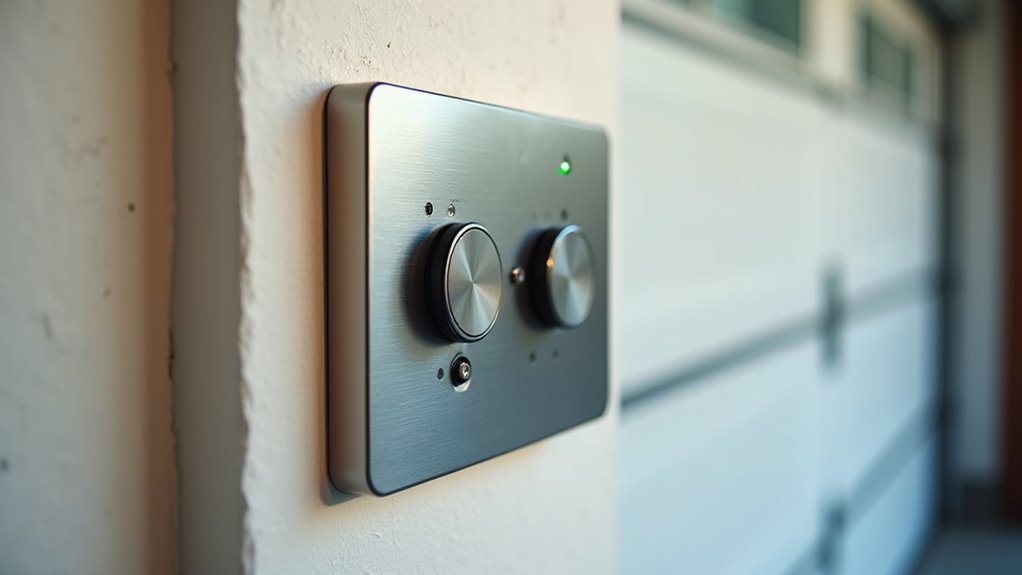
You’ll experience considerably improved reliability with hub-free garage door controls because they eliminate multiple connection points that can fail.
Your system won’t depend on a central hub that requires maintenance or can malfunction, creating a more stable operation overall.
This streamlined approach reduces network dependencies, giving you fewer components that might disconnect or cause system-wide failures.
Fewer Connection Points
Anyone who’s dealt with smart home connectivity issues knows that more components often mean more problems. Hub-free garage door controls eliminate intermediary devices, creating fewer connection points between your smartphone and garage door.
This streamlined approach considerably reduces potential failure points that plague traditional smart garage door openers.
When you remove the hub from the equation, you’re cutting out a common source of connectivity headaches. Your commands travel directly from your device to the garage door opener via Wi-Fi, ensuring reliable communication without additional hardware interference.
This direct connection means you’ll spend less time troubleshooting network issues and more time enjoying seamless operation.
The user-friendly installation process becomes even simpler without hub configuration requirements, making these systems accessible for any homeowner seeking dependable smart garage access.
Reduced Network Dependencies
When your garage door opener connects directly to your home’s Wi-Fi network, you’re eliminating dependency on multiple network layers that can compromise system reliability.
Hub-free systems remove the intermediary device that traditional setups require, creating a more stable connection pathway. This direct approach helps you avoid connectivity issues that stem from hub malfunctions or signal interference between components.
You’ll experience lower latency since commands travel straight from your smartphone to the opener without routing through additional hardware.
This streamlined communication also means fewer devices competing for bandwidth on your network. Hub-free systems reduce installation complexity by requiring only one Wi-Fi connection instead of managing separate hub-to-router and hub-to-opener links.
The simplified architecture helps streamline setup while providing more consistent performance over time.
Cost-Effective Smart Home Solution
While traditional smart garage door systems can cost hundreds of dollars, hub-free garage door controls like the Chamberlain Smart Garage Control offer an affordable entry point at just $24.99.
This cost-effective smart home solution eliminates the need for expensive opener replacements, allowing you to upgrade your existing system instead. You’ll save money by connecting directly to your Wi-Fi network without requiring additional hub devices that increase costs and complexity.
The straightforward installation takes only 20 minutes, reducing professional installation expenses.
You’ll enjoy real-time notifications about your garage door’s status without ongoing subscription fees that burden other smart systems.
This budget-friendly approach delivers essential smart functionality while keeping your smart home investment minimal, making it an ideal choice for homeowners seeking affordable automation.
Streamlined App Control Experience
Why juggle multiple apps when you can control your garage door through one intuitive interface? Hub-free garage door controls deliver a streamlined experience through the myQ app, eliminating the complexity of managing multiple smart home platforms.
You’ll open and close your garage door seamlessly from your iOS or Android device, receiving real-time notifications that keep you informed of your garage’s status instantly.
The myQ app transforms your smartphone into a powerful remote control for your smart garage door opener. You can schedule operations, manage family access, and monitor activity—all from one centralized location.
Turn your smartphone into the ultimate garage door command center with complete scheduling, access management, and activity monitoring capabilities.
This simplified approach means you won’t need to switch between different applications or remember various login credentials. Hub-free garage door controls make smart home automation accessible and straightforward for everyone.
Voice Assistant Integration Capabilities
Beyond app-based control, hub-free garage door systems excel at voice assistant integration, bringing hands-free operation directly to your smart home ecosystem.
You’ll connect seamlessly with Amazon Alexa and Google Assistant without requiring additional hub devices, simplifying your setup process.
Voice commands let you open, close, or check your garage door’s status from anywhere in your home. You can create routines linking garage door controls with other smart home devices—like automatically turning on lights when the door opens.
This hands-free operation proves invaluable when you’re carrying groceries or have your hands full.
Hub-free systems offer straightforward installation, often completed within minutes, giving you immediate access to voice assistant integration capabilities that enhance your daily convenience.
Reduced Network Congestion
Since hub-free garage door controls connect directly to your Wi-Fi network, they eliminate the bottleneck that traditional hub-based systems create on your home network.
These hub-free systems reduce the communication layers between your garage door and router, resulting in reduced congestion and faster response times. When you’re managing multiple smart devices, every connection point matters for peak performance.
Your network management becomes considerably simpler without additional hub devices competing for bandwidth. This streamlined approach guarantees reliable access to your garage door controls, even when other devices are actively using your Wi-Fi connection.
- Fewer devices mean less interference and improved overall network stability
- Direct Wi-Fi connection eliminates potential hub failure points
- Reduced latency creates faster garage door response times
- Simplified troubleshooting with one less device to diagnose
Compatibility With Existing Garage Door Openers
You’ll find that hub-free garage door controls work with most garage door openers manufactured after 1993, provided they use standard safety sensors.
However, you can’t use these systems with certain Chamberlain models featuring yellow learn buttons from 2010-2021 or with Linear openers.
You should verify your opener’s compatibility using the manufacturer’s guidelines or online compatibility tools before purchasing a hub-free control system.
Standard Safety Sensor Requirements
Before upgrading to a hub-free garage door control system, you’ll need to verify that your existing opener meets standard safety sensor requirements for seamless compatibility.
These sensors are essential components that prevent your garage door from closing when objects or people are in the way, ensuring safe operation.
Most garage door openers manufactured after 1993 include standard safety sensors, making them compatible with hub-free garage door controls.
However, certain Chamberlain Group models from 2010-2021 and Linear openers won’t work with these systems.
Key safety sensor requirements include:
- Proper sensor alignment between door jambs at ground level
- Clean sensor lenses free from dirt, debris, or obstructions
- Secure wiring connections that maintain consistent power supply
- Correct installation positioning in the garage door’s top corner for ideal function
Manufacturer Compatibility Limitations
While most garage door openers manufactured after 1993 work seamlessly with hub-free controls, certain manufacturer models present compatibility roadblocks that could derail your smart upgrade plans.
You’ll face specific challenges with Chamberlain Group opener models manufactured between 2010 to 2021 featuring yellow learn buttons, as these aren’t compatible with hub-free systems. Linear openers also won’t work with these controls, despite having standard safety sensors.
| Manufacturer | Compatible Models | Incompatible Models |
|---|---|---|
| Chamberlain Group | Pre-2010, Post-2021 | 2010-2021 (Yellow Learn Button) |
| Linear | None Listed | All Current Models |
| Most Others | Post-1993 with Safety Sensors | Pre-1993 Models |
Before purchasing, you must perform thorough compatibility checks to avoid costly mistakes. Even garage door openers with standard safety sensors aren’t guaranteed to work with all hub-free systems.
Security Features and Remote Monitoring
Several security features distinguish hub-free garage door controls from traditional systems, starting with real-time monitoring that keeps you informed about your garage’s status at all times.
You’ll receive instant notifications when your door opens or closes, eliminating security gaps. The myQ technology enables remote access management, letting you grant controlled entry to family and trusted individuals without physical keys.
- Real-time status alerts guarantee you’re always aware of your garage door’s position
- Remote access control through the myQ app lets you manage entry permissions securely
- Voice commands via Alexa and Google Assistant provide hands-free operation for enhanced convenience
- Scheduled automatic closing prevents unauthorized access by ensuring your garage secures itself
These garage door systems deliver extensive remote monitoring and security features that traditional controllers can’t match.
Energy Efficiency and Battery Life
Beyond providing robust security capabilities, hub-free garage door controls deliver impressive energy efficiency that translates into real cost savings for homeowners. These systems connect directly to Wi-Fi, eliminating additional hardware that constantly consumes power.
The myQ Smart Garage Control operates on a single Lithium Metal battery lasting months, reducing replacement frequency and environmental waste. Real-time notifications help prevent energy loss by alerting you when doors remain open, allowing remote closure.
| Feature | Benefit |
|---|---|
| Direct Wi-Fi Connection | Eliminates power-hungry hub devices |
| Lithium Metal Battery | Extended operation for months |
| Temperature Resistance | Reliable performance without excess consumption |
| Remote Monitoring | Prevents unnecessary energy loss |
| Energy-Efficient Components | Lower electricity bills vs. older models |
Hub-free systems excel in battery life management while maintaining peak energy efficiency.
Troubleshooting and Maintenance Requirements
Although hub-free garage door controls simplify installation by eliminating additional hardware, they still require periodic maintenance to confirm peak performance.
You’ll need to verify your Wi-Fi signal strength remains adequate throughout your garage, as weak connectivity can cause intermittent operation and frustrating malfunctions.
Essential maintenance tasks include:
- Check compatibility – Verify your garage door opener works with smart technology and meets current safety standards
- Monitor Wi-Fi strength – Test signal quality regularly and consider range extenders if needed
- Replace sensor batteries – Check and swap out batteries in sensors and remotes when responsiveness drops
- Update software – Install occasional firmware updates, though these occur less frequently than hub-based systems
Regular troubleshooting involves testing all sensors and verifying smooth operation to prevent unexpected failures.
Comparing Hub-Free Vs Traditional Smart Controls
When you’re choosing between hub-free and traditional smart garage door controls, you’ll notice significant differences in how complex the installation process becomes.
The cost implications extend beyond the initial purchase price, affecting your long-term investment in smart home technology.
You’ll want to weigh these installation and financial factors carefully before deciding which system best fits your needs and budget.
Installation Complexity Differences
Since hub-free garage door controls eliminate the need for additional hardware, you’ll find their installation considerably more straightforward than traditional smart systems.
Hub-free systems connect directly to your garage door opener and smartphone, while traditional smart controls require positioning hubs within router range and configuring multiple devices.
You’ll complete most hub-free installations in under 20 minutes without professional help.
Installation processes for traditional systems often involve complex setup steps that may require expert assistance.
Key installation differences include:
- Component count: Hub-free systems reduce required hardware components
- Setup time: Traditional controls demand longer configuration periods
- Technical complexity: Hub-free options eliminate multi-device coordination challenges
- Professional requirements: Traditional systems frequently need installer expertise
Hub-free systems deliver lower overall costs by removing hub purchase and maintenance expenses.
Cost Analysis Comparison
Beyond installation advantages, hub-free garage door controls offer significant financial benefits that make them an attractive choice for budget-conscious homeowners.
You’ll save $25 to $100 upfront by eliminating the need for a dedicated hub that traditional smart controls require. The installation cost savings continue since hub-free systems connect directly to Wi-Fi, making DIY setup straightforward and potentially saving you $100 to $200 in professional installation fees.
Your ongoing costs remain lower with hub-free systems because they don’t typically require subscription fees for cloud services that hub-based alternatives often impose.
You’ll also enjoy greater flexibility without compatibility restrictions, allowing seamless integration with existing devices. This cost-effective approach delivers smart functionality without the premium price tag associated with traditional hub-dependent garage door controls.
Frequently Asked Questions
Can I Use Myq Without a Subscription?
You can use myQ without a subscription for basic functions like opening, closing, and monitoring your garage door. You’ll receive real-time notifications and access scheduling features completely free.
Is There a Monthly Fee for Myq?
You won’t pay monthly fees for myQ’s basic features. You’ll control your garage door, receive notifications, and access remote functions without subscription costs. Premium features require payment, but core functionality remains free.
Does It Matter What Garage Door Remote I Buy?
Yes, it matters considerably. You’ll need a compatible remote for your specific opener model, especially for pre-1993 systems. Consider security features, operating range, battery life, and convenience options when choosing.
What Does Myq Garage Control Do?
MyQ Garage Control lets you remotely open and close your garage door through a smartphone app, sends real-time status notifications, and integrates with smart home systems for convenient voice control.

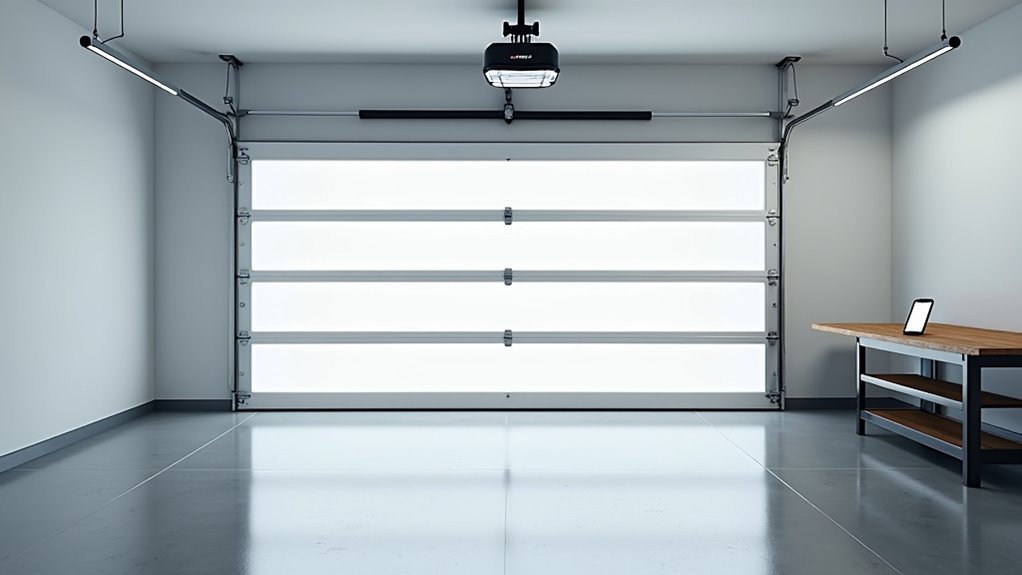

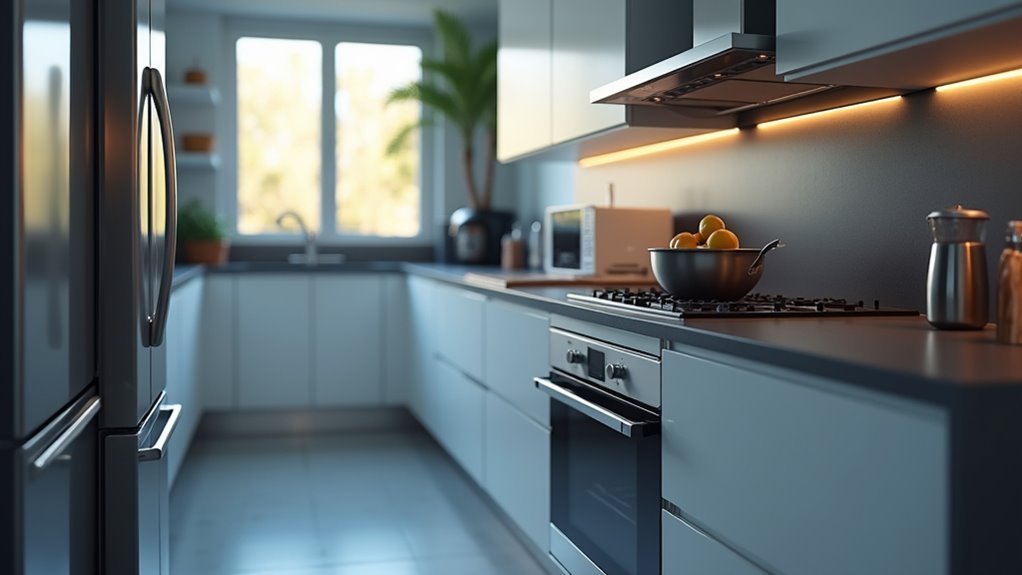
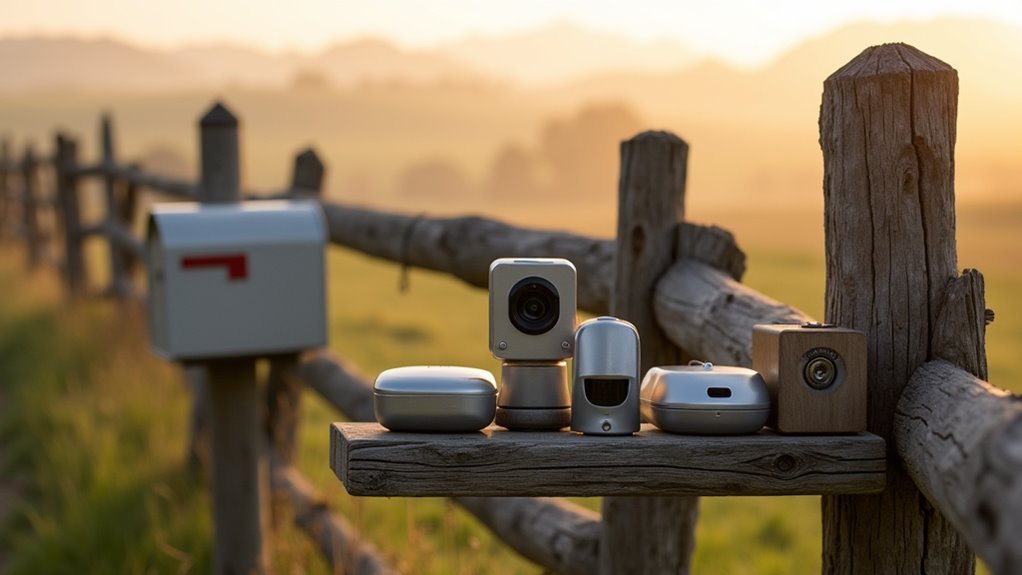
Leave a Reply